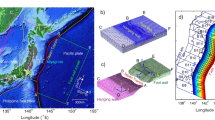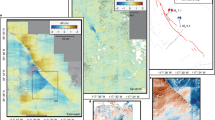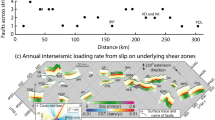Abstract
BOREHOLE tensor strain instruments deployed along the San Andreas fault for the past ten years have provided sufficient resolution and stability to sample regional tectonic processes, potentially enhancing earthquake prediction capability. Data obtained from the instrument at San Juan Bautista, in the near-field region of the 17 October 1989 Loma Prieta earthquake (Ms = 7.1) provide the first opportunity to observe shear strain processes associated with a large earthquake. We previously reported1 a prominent shear-strain anomaly in those data for more than a year before the earthquake. This anomaly ceased immediately after the earthquake, but, as we report here, a new and higher rate of fault-parallel shear accumulation (2 microstrain per year) was established about four months later and has continued to the present. Associated changes in creep rate are apparent at a number of sites on the surface trace of the fault within 30 km of the strain meter. We propose that the observed strain accumulation results from increased slip around a nearby locked section of the fault, this slip arising from loading by the failed Loma Prieta source region to the north. This model is consistent with suggestions of an increased probability of a moderate earthquake near San Juan Bautista9–10, and with evidence12 that interactions between fault regions are important in earthquake processes.
This is a preview of subscription content, access via your institution
Access options
Subscribe to this journal
Receive 51 print issues and online access
$199.00 per year
only $3.90 per issue
Buy this article
- Purchase on Springer Link
- Instant access to full article PDF
Prices may be subject to local taxes which are calculated during checkout
Similar content being viewed by others
References
Gladwin, M. T., Gwyther, R. L., Higbie, J. W. & Hart, R. Geophys. Res. Lett. 18, 1377–1380 (1991).
Gladwin, M. T. Rev. scient. Instrum. 55, 2011–2016 (1984).
Gladwin, M. T., Gwyther, R. L., Hart, R. & Francis, M. J. geophys. Res. 92, 7981–7988 (1987).
Gladwin, M. T. & Hart, R. Pure appl. Geophys. 123, 59–88 (1985).
Berry, D. S. Int. J. Rock Mech. Min. Sci. 4, 181–187 (1967).
Berry, D. S. & Fairhurst, C. Am. Soc. Testing Mat. STP 402, 190–206 (1966).
Johnston, M. J. S. & Linde, A. T. Eos 71, 1461 (1990).
Burford, R. O. Pure appl. Geophys. 126, 499–529 (1988).
Wyss, M. & Burford, R. A. Nature 329, 323–325 (1987).
Sylvester, A. G., Burford, R. O. & Schultz, S. S. Eos 71, 290 (1990).
Lisowski, M., Prescott, W. H., Savage, J. C. & Svarc, J. L. Geophys. Res. Lett. 17, 1211–1214 (1990).
Marko, G. M. J. geophys. Res. 87, 7807–7816 (1982).
Author information
Authors and Affiliations
Rights and permissions
About this article
Cite this article
Gwyther, R., Gladwin, M. & Hart, R. A shear-strain anomaly following the Loma Prieta earthquake. Nature 356, 142–144 (1992). https://doi.org/10.1038/356142a0
Received:
Accepted:
Issue Date:
DOI: https://doi.org/10.1038/356142a0
Comments
By submitting a comment you agree to abide by our Terms and Community Guidelines. If you find something abusive or that does not comply with our terms or guidelines please flag it as inappropriate.



